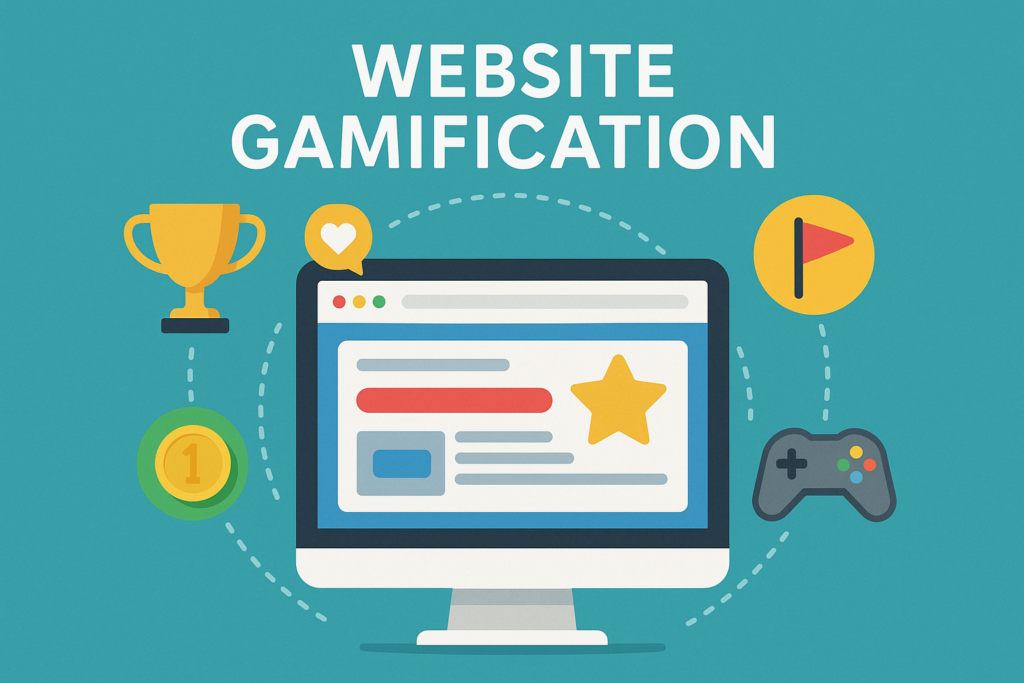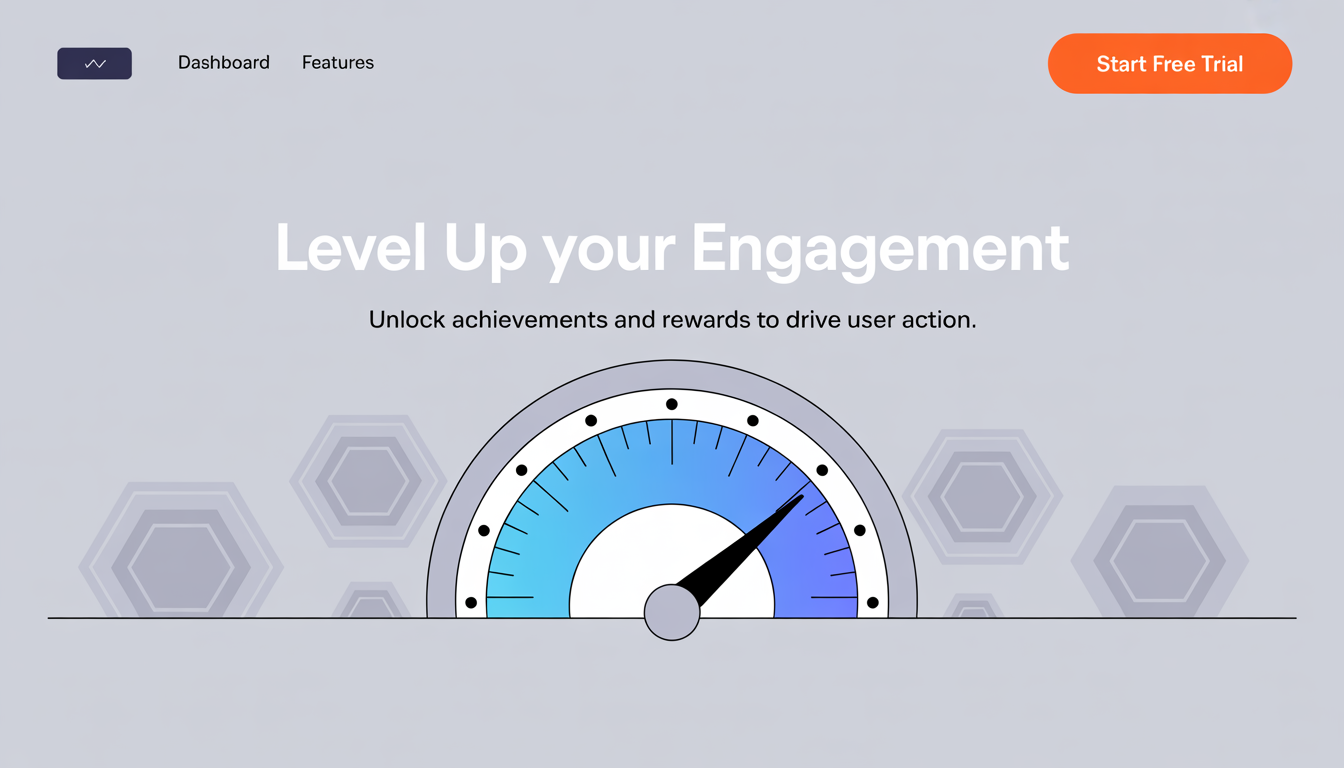In today’s fast-moving digital world, capturing and keeping a visitor’s attention is tougher than ever, but also more critical. That’s where website gamification steps in. This powerful strategy blends interactive design with playful game mechanics to make web experiences not only engaging but surprisingly addictive.
But what exactly makes users come back for more? How can points, badges, or leaderboards actually boost business results? And what are some real-world examples of websites turning simple visits into memorable adventures?
Understanding human motivation holds the secret, and its depth might surprise you. Keep reading to learn how gamification works and why it sparks our natural drive for achievement. Use it to turn your website into a place visitors love to stay.

What Is Website Gamification?
Gamification in web design changes how we use websites. It adds game elements to make interactions fun. This includes rewards like points, badges, and leaderboards to keep users engaged.
The goal is to make everyday tasks fun. It turns boring activities into exciting challenges. Users love to take on these challenges.
Using gamification, businesses can make websites more enjoyable. This approach keeps users coming back for more. It also makes them spend more time on the site.
With challenges and rewards, users are more likely to participate. They enjoy activities like filling out forms or signing up for newsletters. These tasks become less of a chore and more of a fun experience.
Benefits of Gamifying Your Website
Adding gamification to web design is more than a trend. It’s a smart way to make your website more fun and engaging. It turns users into active players, not just visitors. This makes them more likely to stick around.
Also, gamifying your site makes everyday tasks feel like fun challenges. Tasks like filling out a profile or subscribing to a newsletter become part of a game. This makes users want to come back more often.
Another perk is getting a competitive edge. Your site stands out from others by offering a fun, interactive experience. This not only keeps current users interested but also draws in new ones.
By using gamification, websites can see big improvements in how users interact and convert. This approach makes users happy and eager to return. It’s a key to growing your business over time.
Popular Gamification Techniques
Adding game elements to websites is a smart way to keep users engaged and loyal. Leaderboards and competitions are top choices for creating a sense of community and friendly rivalry. They make users want to do more and climb the ranks for recognition, which means they spend more time on these sites.
Using badges and achievements is another great technique. These symbols mark a user’s progress and give them a sense of accomplishment. They let users show off their achievements, making them feel more connected to the site. Points and rewards systems also play a big role. Users get points for interacting with the site, which they can trade for rewards. This keeps users coming back and gives site owners valuable insights to improve the user experience.
These gamification methods do more than just make a site look fun. They are powerful tools that boost user activity, keep people coming back, and provide useful data. By using these elements in a creative and thoughtful way, businesses can greatly improve how users interact with their sites.
How To Implement Gamification on Your Website
Starting with gamification means knowing what you want to achieve. It could be more user engagement or higher sales. A solid plan is key. It’s about knowing what drives your users and making it work for them.
Choosing the right tools is crucial. Platforms like GamiPress and BadgeOS make it easy to add game elements to your WordPress site. For a custom fit, you can create something unique. This way, your gamification fits perfectly with your website.
It’s also important to keep an eye on how well your gamification works. Use analytics to see how users are interacting with your site. This helps you make changes to keep your gamification engaging and effective.

Designing Engaging User Experiences
In the world of digital interaction, interactive website design with gamification is changing how we use websites. It adds fun to browsing, keeping users interested for longer. It also makes the experience more rewarding.
With a user-centric design, we focus on what users enjoy and find easy. This creates a place online that people want to come back to.
Creating an intuitive user experience is key. Users should find it easy to move around the site and understand it right away. This makes them stay longer, which is great when you add gamification.
Things like badges, leaderboards, and quizzes make it fun. They keep users wanting to do more and learn more.
To keep users engaged, every part of the site needs to follow gamification rules. It turns simple actions into exciting moments. When users see their progress and rewards right away, they stay interested and loyal.
Measuring the Success of Gamification
Key Performance Indicators (KPIs) are key for checking if gamification works in digital campaigns. These KPIs show if game elements change user behavior and meet business goals. They look at things like how long users stay, how often they come back, and if they do what we want them to.
Checking if gamification works goes beyond just seeing if people are there. It’s about really understanding how rewards and challenges affect people. For example, if more people start playing, it might mean the gamification is working. But looking closer at how they play can tell us even more about their happiness and if the game meets our goals.
Using advanced tools to track these metrics is very important. Web analytics platforms give deep insights into how users play with gamified parts. Special software also checks how well game mechanics work, helping companies improve their gamification plans.
Keeping an eye on these metrics and making changes based on them is key. It makes sure gamification stays on track with what users want and what the business needs. This ongoing improvement is vital for staying ahead and getting the most out of gamification.
Common Mistakes in Gamification
Exploring website gamification strategies is key to engaging users. But, it’s important to know the pitfalls. Businesses often make their systems too complex from the start. Too many badges, points, and leaderboards can confuse users, making them disengage.
Another mistake is ignoring user feedback. Successful gamification depends on understanding and acting on user experiences. When businesses don’t listen, they miss chances to improve. This can make the experience stale, leading to user boredom and disinterest.
To make gamification work, businesses need to find the right balance. They should start with a simple yet engaging experience. Then, they should grow and change based on user feedback. By avoiding these mistakes, businesses can keep users interested and satisfied over time.
Case Studies: Successful Website Gamification
Looking at gamification case studies shows how successful gamified websites keep users coming back. Duolingo, for example, uses games to make learning fun. It rewards users with points, streaks, and leagues, making learning both enjoyable and competitive.
Starbucks also uses gamification well. Its Rewards program boosts loyalty and sales. Customers earn points for every purchase, encouraging them to visit more often.
These gamification case studies are key for businesses wanting to boost user engagement. Duolingo and Starbucks show the power of clear goals and social features. These are essential for any business aiming to succeed with gamification.
Future Trends in Website Gamification
The future of website gamification is bright, with artificial intelligence (AI) playing a big role. As digital spaces grow, AI will change how we use online platforms. It will make experiences personal and unique, fitting each user’s likes and habits.
The goal is to adapt to user needs perfectly. This means gamification will not just be fun but also meaningful to each user.
Another big trend is understanding user engagement better. Websites will use deep analytics to create challenges that fit each user’s situation. This makes users feel more accomplished and motivated.
Brands need to think about sustainability and ethics in gamification, too. As gamification grows, combining it with green initiatives will make it even more impactful. AI, personalization, and sustainability will shape the future of gamification, opening up new possibilities for everyone.
Level Up Your Website: Turn Users into Engaged Players
Website gamification isn’t just a fun add-on—it’s a powerful strategy for transforming your site into a dynamic, rewarding experience. By weaving in elements like points, badges, and challenges, you shift users from passive visitors to active participants. This approach doesn’t just boost engagement; it creates deeper emotional connections, encourages repeat visits, and turns everyday tasks into meaningful interactions.
In a crowded digital landscape, the most memorable websites are those that feel alive, responsive, interactive, and personalized. With thoughtful gamification, you can build a user experience that’s not only functional but irresistible.
If this inspired you to rethink your own design approach, explore more insights on Mood Joy. I dedicate my blog to sharing UX/UI best practices and creative strategies like gamification that make websites truly stand out.
Visit Mood Joy and sign up for exclusive tips and insights. Discover fresh ideas to craft joyful, engaging digital experiences.



